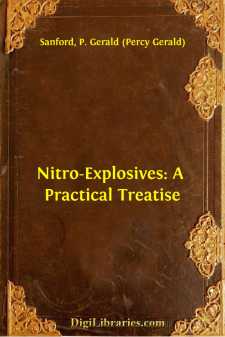Categories
- Antiques & Collectibles 13
- Architecture 36
- Art 48
- Bibles 22
- Biography & Autobiography 813
- Body, Mind & Spirit 141
- Business & Economics 28
- Children's Books 12
- Children's Fiction 9
- Computers 4
- Cooking 94
- Crafts & Hobbies 4
- Drama 346
- Education 46
- Family & Relationships 57
- Fiction 11826
- Games 19
- Gardening 17
- Health & Fitness 34
- History 1377
- House & Home 1
- Humor 147
- Juvenile Fiction 1873
- Juvenile Nonfiction 202
- Language Arts & Disciplines 88
- Law 16
- Literary Collections 686
- Literary Criticism 179
- Mathematics 13
- Medical 41
- Music 40
- Nature 179
- Non-Classifiable 1768
- Performing Arts 7
- Periodicals 1453
- Philosophy 64
- Photography 2
- Poetry 896
- Political Science 203
- Psychology 42
- Reference 154
- Religion 513
- Science 126
- Self-Help 83
- Social Science 81
- Sports & Recreation 34
- Study Aids 3
- Technology & Engineering 59
- Transportation 23
- Travel 463
- True Crime 29
Nitro-Explosives: A Practical Treatise
Categories:
Description:
Excerpt
CHAPTER I.
INTRODUCTORY.
The Nitro-Explosives—Substances that have been Nitrated—The Danger Area—
Systems of Professors Lodge, Zenger, and Melsens for the Protection of
Buildings from Lightning, &c.
The manufacture of the various nitro-explosives has made great advances during late years, and the various forms of nitro-compounds are gradually replacing the older forms of explosives, both for blasting purposes and also for propulsive agents, under the form of smokeless powders. The nitro-explosives belong to the so-called High Explosives, and may be defined as any chemical compound possessed of explosive properties, or capable of combining with metals to form an explosive compound, which is produced by the chemical action of nitric acid, either alone or mixed with sulphuric acid, upon any carbonaceous substance, whether such compound is mechanically mixed with other substances or not.[A]
[Footnote A: Definition given in Order of Council, No. 1, Explosives Act, 1875.]
The number of compounds and mixtures included under this definition is very large, and they are of very different chemical composition. Among the substances that have been nitrated are:—Cellulose, under various forms, e.g., cotton, lignin, &c.; glycerine, benzene, starch, jute, sugar, phenol, wood, straw, and even such substances as treacle and horse-dung. Some of these are not made upon the large scale, others are but little used. Those of most importance are nitro-glycerine and nitro-cellulose. The former enters into the composition of all dynamites, and several smokeless powders; and the second includes gun-cotton, collodion-cotton, nitrated wood, and the majority of the smokeless powders, which consist generally of nitro-cotton, nitro-lignin, nitro-jute, &c. &c., together with metallic nitrates, or nitro-glycerine.
The nitro-explosives consist generally of some organic substance in which the NO_{2} group, known as nitryl, has been substituted in place of hydrogen.
Thus in glycerine,
|OH C_{3}H_{5}|OH, |OH
which is a tri-hydric alcohol, and which occurs very widely distributed as the alcoholic or basic constituent of fats, the hydrogen atoms are replaced by the NO_{2} group, to form the highly explosive compound, nitro-glycerine. If one atom only is thus displaced, the mono-nitrate is formed thus,
|ONO_{2} C_{3}H_{5}|OH; |OH
and if the three atoms are displaced, C_{3}H_{5}(ONO_{2})_{3}, or the tri- nitrate, is formed, which is commercial nitro-glycerine.
Another class, the nitro-celluloses, are formed from cellulose, C_{6}H_{10}O_{5}, which forms the groundwork of all vegetable tissues. Cellulose has some of the properties of the alcohols, and forms ethereal salts when treated with nitric and sulphuric acids. The hexa-nitrate, or gun-cotton, has the formula, C_{12}H_{14}O_{4}(ONO_{2})_{6}; and collodion-cotton, pyroxylin, &c., form the lower nitrates, i.e., the tetra- and penta-nitrates. These last are soluble in various solvents, such as ether-alcohol and nitro-glycerine, in which the hexa-nitrate is insoluble....


